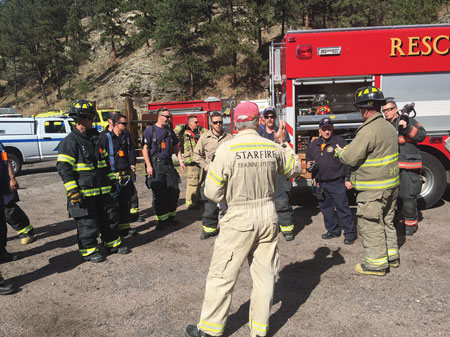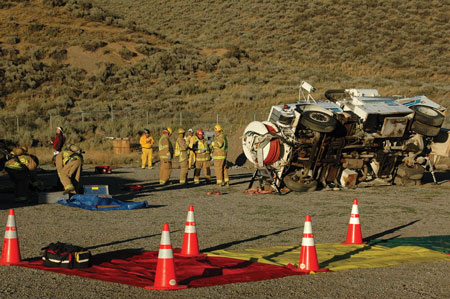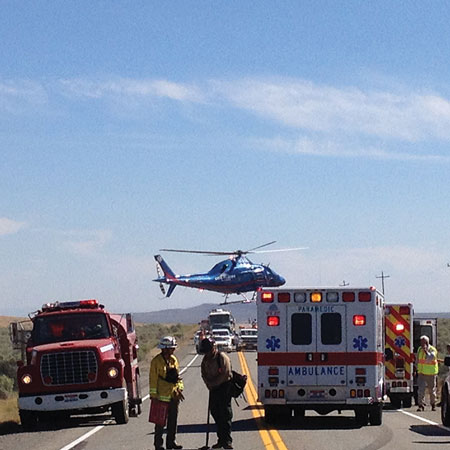
BY CRAIG ABERBACH
As a company officer or an emergency services responder in any capacity, if you are first to arrive on the scene of a motor vehicle accident (MVA), having a solid foundation of the following will ensure a well-executed outcome. Knowing your responsibilities, capabilities, crew, equipment, resources, and other program functions will help ensure you have the know-how to do your job.
Responsibilities
Knowing your responsibilities as a first-arriving responder is important. Your number-one responsibility is to your crew, ensuring members will get to the scene safely and are adequately prepared to fulfill your assignments. Accident victims are actually the third priority after bystanders, whom we do not want getting in the way or hurt.
On arrival, you announce “on scene” and assume command. Showing a strong, confident assessment and size-up will set the tone for the remainder of the call. Make sure your apparatus is positioned to keep the scene safe and provide the best access for tools and equipment. Communicate with other responders if you are blocking access or if they will be arriving from a different direction. Ensure ambulances and other vehicles have a way in and out, and identify where they can safely turn around. Our number-one objective is to stabilize the scene.
 |
| (1) Photos by author unless otherwise noted. |
Next, stabilize the vehicles, and then safely medically evaluate and stabilize the victims. Responders should never get tunnel vision-once you arrive on the scene, get the 10,000-foot view. Get an accurate snapshot of what is going on. You have to do a complete 360° scene survey, if possible, to get an accurate account of what happened and the hazards that might not be visible on your initial approach. This typically is called walking both the outer and inner circles around the entire scene and each vehicle. Too many times, responders commit themselves to aiding a nonpriority victim because they take care of the first patient they come in contact with, or they get called elsewhere by bystanders. The first-due company officer or responder on the scene must set the stage and tone for what develops next.
Know Your Crew
Knowing your crew members and their experience level will aid you in decision making. Are these the members you work with all the time? Are you swinging in for the shift? Is this a mixed volunteer response and you’re unsure of the capabilities? Does each responder with you have a predetermined role, or do you wait until you arrive at the scene to give directions and orders? No two situations are exactly alike. However, having a game plan in advance may alleviate confusion on arrival. Having good, clear communications and setting expectations will avoid any misconceptions about orders or directions given on the emergency scene (photo 1).
Know Your Equipment
Just as important as knowing your crew and its capabilities is ensuring your company knows the equipment carried and its proper use. I have worked with too many fire departments teaching extrication classes that have a great equipment cache, but most of its members are not properly trained in the use and maintenance of the equipment. If your department uses wood cribbing, ensure it is appropriate for the task. Is it soft wood, which will split when pressure is applied? Does your department use struts? Do members check the webbing after each use? Are hydraulic tools tested for proper working pressures? When was the last time you checked the oil level in your hydraulic tools or used pneumatic oil to lubricate your air tools? Ask your fellow firefighters these questions. If you or your fellow firefighters don’t know, there might be a problem.
Know Your Capabilities
Knowing your capabilities is a multipart equation. First, evaluate your capabilities and responsibilities. Are you on an engine company charged with those functions (extrication) or a rescue [advanced life support/emergency medical services (EMS)] with a primary focus on the injured? Second, do you have enough crew members to fill the immediate needs? On a minor entrapment with one injured inside a vehicle and the only hazard a small fuel leak, you can fill the most needed positions with the initial-arriving company as follows: incident command, pump operator for a preconnect to protect operations (because of the fuel leak and use of hydraulics), vehicle stabilization (two), safety officer, traffic control, hydraulic tool operators (two), nozzleman, and patient care (two).
 |
| (2) Photo courtesy of the Hailey (ID) Fire Department. |
On a basic bread-and-butter operation, you may need up to 11 responders to fill all the needed positions. Typically, the first three or four firefighters who arrive must fill those positions. You must multitask and communicate effectively, relaying assignments to other responding units or agencies. Just as important, know their individual levels of competence and ensure they have the tools to accomplish assignments.
Know Your Communication Plan
Using the incident command system (ICS) will aid in communication, especially if multiple jurisdictions or agencies respond, such as other fire, EMS, law enforcement, utility departments, and wrecker companies. Expansion to a unified command system may be necessary at large-scale incidents. Every jurisdiction has its needs and priorities. The fire service typically looks at the big picture-the overall scene. Law enforcement’s priority is usually getting traffic flowing and getting as many lanes of traffic open as soon as possible, even if it might possibly compromise scene safety. EMS responders typically want to get to the patient immediately to begin necessary life-saving measures, even in unstable situations. With all these factors, it is imperative to have a good, clear command system in place where priorities and agency needs are established for the number-one priority, scene safety. This is essential for continuity of operations (photos 1 and 2).
Know Your Resources
Most responders typically focus on internal resources, the equipment they have on their apparatus or within their department. Resources can be people, vehicles, or equipment. Responders should also be aware of the available external resources. Most fire departments in cities or counties are part of a larger organization (e.g., a city, a county, a mutual- or an automatic-aid organization). During extended emergencies, this organization can handle duties such as closing streets or setting up detours, using law enforcement or street departments. If the spill is large, utility departments can bring in sand to absorb or dike spills and use street sweepers to aid in clearing emergency scenes after an incident. This will assist all involved in getting back into service more quickly. Private industry resources can range from wrecker services to crane companies for large MVAs.

Know Your District
You are responsible for knowing your district and being aware of road closures, detours, and construction areas to plan accordingly so your response to the emergency is not delayed. Communicate regularly with your street and utility departments concerning any activity affecting your response. Once road closures are identified, ensure communication (dispatch) is notified and ask that you be made aware of when these roads are reopened.
Know Your Options
Knowing your options means choosing the right tactic and tools to accomplish your objectives. As the officer in charge, you must know the capabilities of the crew members on hand and those responding. Set up and communicate your action plan. As you are working on plan A, make sure you are starting to formulate plans B and C.
Train
Your responsibilities begin on your first day as an emergency responder. Training should be a constant in the fire service. As a recruit firefighter, it was instilled in me that “when you feel you don‘t need to train, it’s time to retire.” You are a member of a professional organization regardless of whether you work for a full-time, a paid-on-call, or an all-volunteer fire department; there is no excuse for not training. Consider that football, baseball, and every other amateur or professional athlete trains almost every day. Most participate in pretraining camps or workshops before their seasons even start. High school football players attend training prior to the school year. With the hazards and challenges that the emergency services face every day, we must be as vigilant as ever with our training. We must go out, get our hands dirty, and train.

Just as important, get to know your external partners. Bringing in external resources for training expands our capabilities, allowing us to use tools and equipment to which we don’t usually have access and to cross-train with other departments. Meet with other department heads in your community to see if they have old vehicles, large or small, to set up extrication training for little or no cost (photo 3). Many local municipal governments have vehicle “deadlines”-vehicles that are no longer roadworthy. See if you can acquire them for training. Set up scenarios where you can train with local law enforcement, EMS, automatic-aid or mutual-aid departments, and dispatchers (photo 4).
New Vehicle Technology
We must open our eyes to the changes in the way new vehicles are constructed. Take your crews to the junkyard and look at how cars are built. Just as important, visit your local new car dealerships and look at the new cars, checking the location of batteries and air bag systems. Talk to the mechanics there to learn how to safely deenergize hybrid vehicles. Learn which vehicles have multiple batteries. New vehicle technology has been evolving every year. Check manufacturer Web sites and sites such as http://www.autonews.com/ for current vehicle technology innovations.
 |
| (5) Photo courtesy of Wood River (ID) Fire and Rescue. |
Having a basic foundation of extrication as a junior firefighter and continually training to improve your skills, techniques, and rescue knowledge will better enable you to effectively manage a large-scale MVA. Following these basic principles and ensuring good command practices with clear communication will help the first-in officer to direct a more successful operation (photo 5).
CRAIG ABERBACH, a 28-year veteran of the fire service, is chief of the Hailey (ID) and assistant chief of the Wood River (ID) Fire Departments. Previously, he was a member of the Cape Coral (FL) Fire Department for more than 22 years, working through the ranks up to division chief. He has a master’s degree in management. Aberbach served as a course designer and an instructor at the Florida State Fire College. He was Florida’s 2000 Fire Service Instructor of the Year.
Craig Aberbach will co-present “Advanced Extrication: Real World Challenges” on Monday, April 18, and Tuesday, April 19, at FDIC International 2016 in Indianapolis.
First-Due Tasks At An MVA
Patient Care Approach to Extrication
Rescue Real Estate: Simultaneous Operations at a MVC
Fire Engineering Archives

